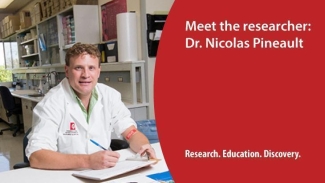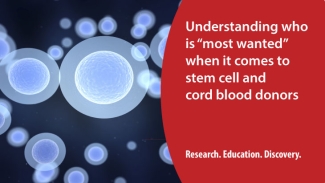July marks Cord Blood Awareness Month in certain places around the world. In homage to this important campaign we collected a few related stories from the RED archives and share a bit more information about why Cord Blood matters.
Cord blood stem cells can be used in the treatment of more than 80 different diseases and disorders. By donating their baby’s cord blood, parents have the power to help patients living with diseases such as leukemia, lymphoma, aplastic anemia, and sickle cell disease. Researchers continue to explore the possibilities of using cord blood in many other treatments.
At any given time, there are hundreds of Canadian patients searching for an unrelated stem cell donor. Cord blood might just be the chance they need.
There are three main advantages to using cord blood:
- Cord blood is collected, tested, and stored. Once it is stored, it is ready and available for patient use. This decreases the wait times for patients when searching for a stem cell donor.
- It is easier to match patients with cord blood. Before they have a transplant, patients have tissue typing tests to match the proteins in their blood — the HLA markers or histocompatibility antigens — to those of potential donors. With adult donors, a perfect or near perfect match to the patient is required for the best outcome. Cord blood stem cells, however, are immunologically immature compared to adult stem cells, so more lenient HLA matching is possible. This increases the possibility of finding a match for patients, and is especially good news for patients who tend to be harder to match — such as those from ethnically diverse backgrounds.
- Because cord blood cells are immunologically immature compared to adult stem cells, patients are less likely to develop complications such as a graft host disease, which may occur when receiving a stem cell transplant.
Canadian Blood Services’ National Cord Blood Bank collects cord blood at hospitals in four Canadian cities (Ottawa, Brampton, Edmonton and Vancouver) and prepares it for frozen storage. Banked cord blood must meet strict quality standards to ensure that it is both safe and effective.
Cord Blood – Frequently Asked Questions
During cord blood awareness month, make time to learn more at www.givelifetwice.ca
Did you know Canadian Blood Services has a Cord Blood for Research program?
Launched in August 2014, it is a partnership between Canadian Blood Services and The Ottawa Hospital. Cord blood units that are not suitable for banking are provided, with mothers’ consent, to investigators that pursue approved discovery or development research. Since its inception, the program has distributed more than 400 fresh cord blood units collected at The Ottawa Hospital to researchers. In the absence of the program, these fresh cord blood units that did not meet the initial criteria for storage in the Cord Blood Bank were discarded.
- Read the full story: Expanding our cord blood for research program

Improving standards related to cord blood collection
Dr. Nicolas Pineault's lab, at our head office in Ottawa, focuses on developing procedures and improving standards related to the collection of cord blood units for Canadian Blood Services’ Cord Blood Bank.
Dr. Pineault and his team conduct tests using the same equipment we use in our cord blood processing facilities. This way his research team can perform realistic studies, such as testing and comparing processes related to the thawing of cord blood units. This work will help determine the ideal procedures for transplant centres to follow when preparing to transplant stem cells from cord blood in a patient.
- Read the full story: Meet the Research: Dr. Nicolas Pineault
Further reading:
Canadian Blood Services – Driving world-class innovation
Through discovery, development and applied research, Canadian Blood Services drives world-class innovation in blood transfusion, cellular therapy and transplantation—bringing clarity and insight to an increasingly complex healthcare future. Our dedicated research team and extended network of partners engage in exploratory and applied research to create new knowledge, inform and enhance best practices, contribute to the development of new services and technologies, and build capacity through training and collaboration. Find out more about our research impact.
The opinions reflected in this post are those of the author and do not necessarily reflect the opinions of Canadian Blood Services nor do they reflect the views of Health Canada or any other funding agency.
Related blog posts
Dr. Pineault and his team are working on a cellular therapy to improve engraftment (the process through which new blood-forming cells start to develop in the patient) following cord blood stem cell transplantation.
On that front, Canada is doing a very good job. Dr. David Allan, medical director for Canadian Blood Services’ Cord Blood Bank and OneMatch Stem Cell and Marrow Network, reports that more than 1,000 units of cord blood are now available in the public Cord Blood Bank.

